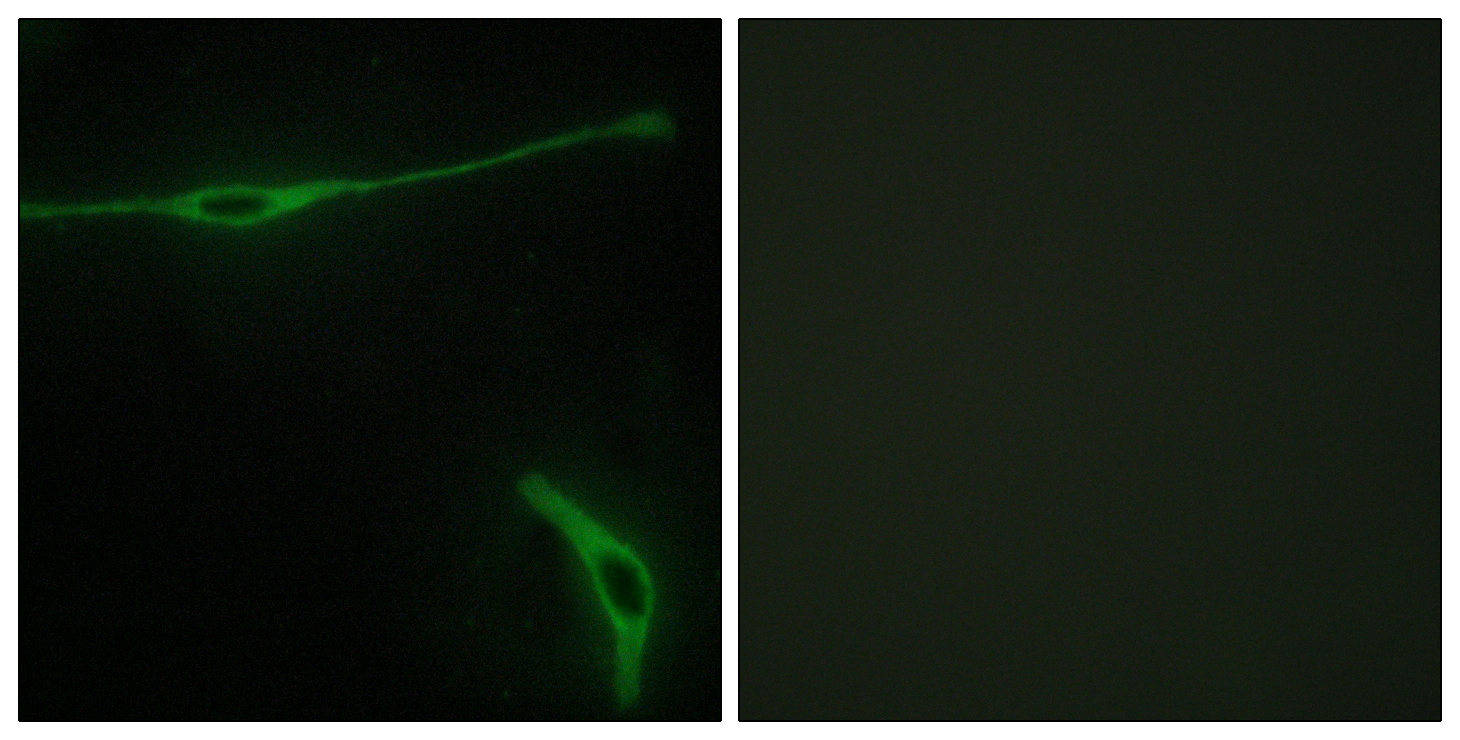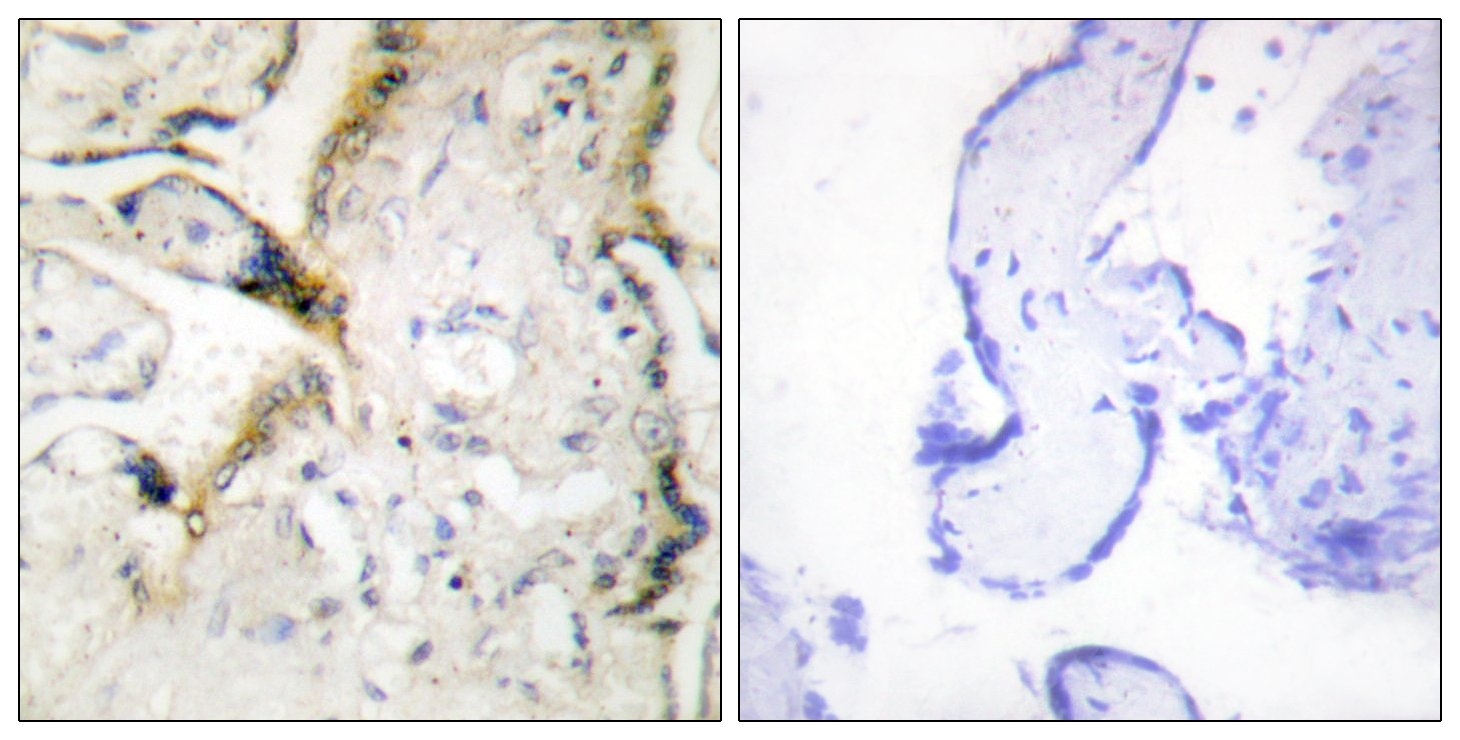Laminin α-2 Polyclonal Antibody
- Catalog No.:YT2524
- Applications:IHC;IF;ELISA
- Reactivity:Human;Mouse
- Target:
- Laminin α-2
- Fields:
- >>PI3K-Akt signaling pathway;>>Focal adhesion;>>ECM-receptor interaction;>>Toxoplasmosis;>>Amoebiasis;>>Human papillomavirus infection;>>Pathways in cancer;>>Small cell lung cancer;>>Hypertrophic cardiomyopathy;>>Arrhythmogenic right ventricular cardiomyopathy;>>Dilated cardiomyopathy;>>Viral myocarditis
- Gene Name:
- LAMA2
- Protein Name:
- Laminin subunit alpha-2
- Human Gene Id:
- 3908
- Human Swiss Prot No:
- P24043
- Mouse Swiss Prot No:
- Q60675
- Immunogen:
- The antiserum was produced against synthesized peptide derived from human LAMA2. AA range:2011-2060
- Specificity:
- Laminin α-2 Polyclonal Antibody detects endogenous levels of Laminin α-2 protein.
- Formulation:
- Liquid in PBS containing 50% glycerol, 0.5% BSA and 0.02% sodium azide.
- Source:
- Polyclonal, Rabbit,IgG
- Dilution:
- IHC 1:100 - 1:300. IF 1:200 - 1:1000. ELISA: 1:20000. Not yet tested in other applications.
- Purification:
- The antibody was affinity-purified from rabbit antiserum by affinity-chromatography using epitope-specific immunogen.
- Concentration:
- 1 mg/ml
- Storage Stability:
- -15°C to -25°C/1 year(Do not lower than -25°C)
- Other Name:
- LAMA2;LAMM;Laminin subunit alpha-2;Laminin M chain;Laminin-12 subunit alpha;Laminin-2 subunit alpha;Laminin-4 subunit alpha;Merosin heavy chain
- Molecular Weight(Da):
- 343kD
- Background:
- Laminin, an extracellular protein, is a major component of the basement membrane. It is thought to mediate the attachment, migration, and organization of cells into tissues during embryonic development by interacting with other extracellular matrix components. It is composed of three subunits, alpha, beta, and gamma, which are bound to each other by disulfide bonds into a cross-shaped molecule. This gene encodes the alpha 2 chain, which constitutes one of the subunits of laminin 2 (merosin) and laminin 4 (s-merosin). Mutations in this gene have been identified as the cause of congenital merosin-deficient muscular dystrophy. Two transcript variants encoding different proteins have been found for this gene. [provided by RefSeq, Jul 2008],
- Function:
- disease:Defects in LAMA2 are the cause of merosin-deficient congenital muscular dystrophy type 1A (MDC1A) [MIM:607855]. MDC1A is characterized by difficulty walking, hypotonia, proximal weakness, hyporeflexia, and white matter hypodensity on MRI.,domain:Domains VI, IV and G are globular.,domain:The alpha-helical domains I and II are thought to interact with other laminin chains to form a coiled coil structure.,function:Binding to cells via a high affinity receptor, laminin is thought to mediate the attachment, migration and organization of cells into tissues during embryonic development by interacting with other extracellular matrix components.,similarity:Contains 1 laminin N-terminal domain.,similarity:Contains 17 laminin EGF-like domains.,similarity:Contains 2 laminin IV type A domains.,similarity:Contains 5 laminin G-like domains.,subcellular location:Major component.,subunit:Laminin
- Subcellular Location:
- Secreted, extracellular space, extracellular matrix, basement membrane. Major component.
- Expression:
- Placenta, striated muscle, peripheral nerve, cardiac muscle, pancreas, lung, spleen, kidney, adrenal gland, skin, testis, meninges, choroid plexus, and some other regions of the brain; not in liver, thymus and bone.
- June 19-2018
- WESTERN IMMUNOBLOTTING PROTOCOL
- June 19-2018
- IMMUNOHISTOCHEMISTRY-PARAFFIN PROTOCOL
- June 19-2018
- IMMUNOFLUORESCENCE PROTOCOL
- September 08-2020
- FLOW-CYTOMEYRT-PROTOCOL
- May 20-2022
- Cell-Based ELISA│解您多样本WB检测之困扰
- July 13-2018
- CELL-BASED-ELISA-PROTOCOL-FOR-ACETYL-PROTEIN
- July 13-2018
- CELL-BASED-ELISA-PROTOCOL-FOR-PHOSPHO-PROTEIN
- July 13-2018
- Antibody-FAQs
- Products Images

- Immunofluorescence analysis of NIH/3T3 cells, using LAMA2 Antibody. The picture on the right is blocked with the synthesized peptide.

- Immunohistochemistry analysis of paraffin-embedded human placenta tissue, using LAMA2 Antibody. The picture on the right is blocked with the synthesized peptide.



